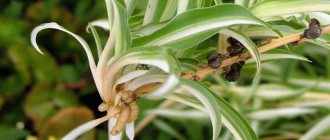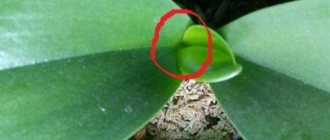The subtribe Catasetumaceae includes several genera, including many species and hybrids, including the luxurious black orchid Fredclarkeara, created by the famous American orchid breeder Fred Clark. Katasetum, as the most numerous of them, gave its name to the entire group.
Carrot orchids are popular among gardeners precisely because of their unusual nature, which is associated with a pronounced seasonality in their development. Bright colors, pleasant aroma, unusual flower shapes, completely different flowering on one plant, colorful pseudobulbs - all together create an incredible aura of exoticism and mystery around carrot orchids, attracting more and more people who want to place these wonderful orchids in their apartments.
Carrots have different structures, sizes and flower shapes, but the structural features of the entire plant are the same. The most distinctive feature is the shape of the pseudobulb, which resembles a spindle or a well-known root vegetable, although to the inhabitants of the American continent it looks like a pointed cigar.
Diseases and pests
Catasetums very rarely get sick.
Diseases occur due to waterlogging of the soil. Wet soil causes the development of fungi, leading to rotting of the root system. If the roots of the orchid begin to rot, it should be replanted after first removing parts of the damaged roots using a disinfected scalpel. The roots must also be treated with Fitoverm. The plant needs to be replanted into a new pot and fresh substrate. The most dangerous pests for crops are flat beetles and spider mites. If the gardener notices the appearance of cobwebs or small brown bugs on the leaves, the orchid should be immediately treated with the Actellik insecticide according to the instructions on the package.
Among the problems in growing catasetum, one can note the lack of flowering and dropping of buds. An orchid stops blooming if the dormant period is not observed. And the buds begin to fall off when temperatures are too low and there is insufficient or excess lighting.
With proper care of the catasetum orchid, none of the problems listed above will arise, and the exotic culture will delight the gardener with its bright, incredibly decorative, pleasantly smelling flowers for many years.
Humidity and watering
Burrageara orchid care
Summer for hatiora is a period of growth and active formation of new segments. During this period, care involves regular, fairly abundant watering and fertilizing. Water only when the top layer of soil is completely dry, using only warm, settled water. Half an hour after watering, drain excess water from the pan. Excess moisture, as well as watering with cold water, leads to rotting of the roots.
Flowering is preceded by a period of complete dormancy - time for the formation of flower buds. Also, rest is necessary in the spring after flowering. During this period, care is as follows:
- almost complete absence of watering;
- kept in cool conditions.
Hatiora tolerates dry air quite well, but during hot periods it is recommended to increase the ambient humidity by:
- regular spraying;
- use a tray with moistened peat or pebbles.
Basic principles of catazetum care
Why do orchid buds fall off: the main reasons for dropping them
Caring for orchids in this section is somewhat different from maintaining other genera.
So, what is needed to care for them:
- Light moisture-absorbing soil, you can use pure pine bark, you can use 50/50 bark with sphagnum moss, with enough experience you can grow it only in moss;
- Abundant watering and fertilization during the growth period. You can feed with foliar fertilizers or applied to the soil. “Carrots” respond well to organic fertilizers; you can also use complex fertilizers for any type of indoor plants;
- As soon as the leaves begin to turn yellow, stop feeding and reduce watering. The plant is going to rest; fertilizers can stimulate the unwanted growth of weak autumn shoots;
- After the leaves fall off, watering stops completely. You can remove the pseudobulbs from the ground, trim off the dead roots and put all the “carrots” in a dry box for storage until spring awakening;
- When the buds emerge from the rhizome at the base of the pseudobulbs, the catazetum ones need to be fixed vertically above the ground so that the new working roots are properly fixed in the pot. Flowerpots for them can be taken either ceramic or plastic. For large species, it is better to use heavier unglazed ceramics;
- The lighting should be bright, but without direct sunlight, which will burn the tender leaves. The ideal side would be eastern facing;
- Orchids of this group do not tolerate flooding, therefore they cannot be watered from above so that water gets into new growths, they cannot be sprayed, and the lower parts of the pseudobulbs cannot be too wet;
- A weekly inspection of the leaves, especially their reverse side, is required. Orchids in this section are very fond of the red mite, so treatments against it with acaricides should be carried out at least three times during the spring-summer season.
Reproduction of catazetums will not cause much difficulty and will appeal to all lovers of these orchids. It is believed that for normal growth a plant must have 2-3 adult pseudobulbs. Therefore, as soon as the bush grows to 4-5 “carrots”, you can safely divide it carefully along the rhizome into two separate plants. If this is not done, then catazetums are able to quickly “eat” the reserves accumulated in the posterior pseudobulbs, after which they will simply die. After the division method described above, growth buds awaken on each of the new plants, the roots from which will provide the plants with everything they need.
Top dressing
Complex, mineral fertilizers for orchids are well suited for nutrition. They contain a balanced composition necessary for this type of plant. Specialists took care of different forms of release. On sale you can find:
- Liquid fertilizers for preparing a nutrient solution,
- Fertilizers in the form of tablets or powder,
- Applicators have appeared relatively recently. They are convenient and economical. Each bottle is sealed. Before use, you must cut off the tip of the long spout and place it in the substrate. Liquid fertilizer gradually enters the soil mixture using the drip irrigation principle. Typically, the contents of one 30 ml package flow out within 2 days. After this, the empty bottle can be removed from the pot. This feeding is enough for a month. While regular liquid fertilizer evaporates within a week.
In addition to applicators, solid fertilizers – long-acting sticks – are popular. One sticker is enough for 100 days. Using fertilizer is not difficult if you take into account the following features:
Before adding the stick to the substrate, it needs to be watered. Fertilizer cannot dissolve in a dry environment. Insert the stick into the soil mixture away from the roots
Direct contact may cause burns. It is important to ensure that the sticker is always wet. Do not use fertilizer during the dormant period.
Types and varieties of catasetum orchids
Phalaenopsis propagation at home: examples by children and cuttings
Catasetum Barbatum - in the wild, the crop grows in the Amazon and Brazil. The plant reaches a height of up to 50 centimeters and has two-row lanceolate, pointed light green leaf plates. The inflorescences are large with yellow speckled petals and a bright yellow fringed lip. Flowering time occurs at the end of summer - beginning of autumn.
Catasetum cap-shaped - grows in its natural habitat in Colombia, Ecuador and Venezuela. The orchid reaches a height of up to 60 centimeters. It has club-shaped pseudobulbs with a diameter of up to 8 centimeters. The leaves are light green, lanceolate with a sharp tip. The peduncle reaches a length of up to 40 centimeters and has ivory racemose inflorescences with purple spots and a yellowish lip. The orchid blooms in mid-autumn.
Catasetum Large-fruited - grows in the wild in Argentina and North America. It reaches a height of up to 70 centimeters and has a 50 centimeter peduncle. The leaf blades are green, lanceolate with a sharp end. The inflorescences are large, waxy yellow-green. The outer petals form a sort of hood, and the lower petal is light green with fine purple flecks.
Spotted Catasetum
The orchid reaches a height of up to 70 centimeters. It has sinuous pseudobulbs and lanceolate, erect leaf blades of a light green hue. The peduncle reaches 50 centimeters. It contains a large number of inflorescences, most of which are male. They have a yellow-green tint and crimson specks. During flowering, the crop emits a musky aroma. The orchid blooms from early autumn to late winter.
Catasetum fringed (Barbatum) - in the wild, the crop grows in Brazil and the Amazon. It reaches a height of up to 60 centimeters. The peduncle grows up to 40 centimeters. The leaves are light green, straight, large with a pointed end. The inflorescences are waxy, large, yellow-green with dark specks and a fringed lip. The crop blooms from late summer to early autumn.
Katasetum Saccatum - the plant reaches a height of up to 70 centimeters and has a thin, elastic long peduncle. Pseudobulbs are slightly curved and reach a length of up to 20 centimeters. The leaf blades are light green, lanceolate with a pointed end. The inflorescences are small, dark crimson in color with a large yellow-orange speckled lip. Flowering time is in summer.
Catasetum Expansum - the orchid reaches a height of up to 60 centimeters. The leaf blades are lanceolate, pointed, erect, green. The peduncle is long with numerous bell-shaped inflorescences of a yellow-green hue. Male inflorescences are larger and brighter, while female inflorescences are smaller. During flowering, the plant emits a pleasant, sweetish aroma.
Katasetum Osculatum
In the wild, the orchid grows in Brazil. The plant's pseudobulbs are erect. The leaf blades are light green, lanceolate with a wavy edge. The peduncle reaches a length of up to 50 centimeters. There are up to 20 inflorescences on it. Female inflorescences are larger, male inflorescences are small. The flowers are waxy, with light yellow mottled petals and a protruding light yellow lip on which is a protuberance resembling an open mouth.
Catasetum Atratum - in its natural habitat, the epiphyte grows in Brazil. It has spindle-shaped pseudobulbs and long, light green leaves with veins and a sharp tip. The inflorescences are waxy, pleasantly smelling, large. They have a yellow-green tint and dark crimson specks. The upper petal resembles a hood with a velvety edge.
Catasetum Luridum - the height of the crop reaches up to 40 centimeters. It has fusiform pseudobulbs with a diameter of up to 15 centimeters. The leaf blades are light green, long, lanceolate with a sharp end. The peduncle reaches a length of up to 50 centimeters. It is decorated with up to 20 round, yellow inflorescences, reminiscent of an open bird's mouth. The orchid blooms in summer.
Catasetum Tenebrosum - in the wild, the crop grows in the Andes, Peru and Ecuador. The orchid reaches a height of up to 35 centimeters. It has fusiform, knotty pseudobulbs and long, ovate leaf blades. The peduncle reaches a length of up to 40 centimeters and has an arched shape. Up to 20 inflorescences appear on it. The female flowers are dark red in color and have a greenish lip, while the male flowers are chocolate purple in color and have a honey-green lip. The crop blooms from March to October.
Catasetum orchid blossoms
In the catasetum orchid, the appearance of the inflorescences is divided by gender. Male flowers are larger, have a complex structure and are much more numerous on the peduncle than female flowers. They are turned upside down and have a funnel-shaped, protruding lip that resembles an overhanging bowl. Their petals are fleshy, oval-elongated.
The female inflorescences are small, there are much fewer of them on the peduncle. They have a helmet-shaped lip and less bright colors. The culture throws out flower stalks immediately after the dormant period. The inflorescences have a variety of colors from white and light green to purple, black and two-color speckled shades.
Flowering time can last from several weeks to several months. The crop blooms from early spring to late autumn. Flowering time depends on the variety.
Description
The genus Katasetum from the Orchid family unites pure species and hybrids.
Orchids, most of them epiphytic, grow in Central and South America. Catasetums are quite large plants. The height of the fusiform pseudobulbs reaches 20 cm. The leaf blades are elongated and small, narrow and wide. Leaf color is all shades of green.
Catasetums are unique orchids. In general, it is not surprising that flowers of different species differ in shape, size and color. The highlight is that all the “variations” are found on one plant. That is, two adjacent peduncles may contain flowers that are not similar to each other. This is because Catasetum flowers are bisexual, and the differences between male and female are very distinct.
Options for displaced flowering are rare in culture. As a rule, indoor Katasetum produces flowers of only one sex. The number of buds on a peduncle can range from several to several dozen. They bloom alternately or simultaneously. Flowering lasts from 1.5 weeks to 2 months. The coloring can be plain or patterned. Sepals and petals are wide open. The lip is large with a rugged or fringed edge.
Katasetum is considered an easy-to-care plant. And it is confidently included in the group of the most popular orchids in indoor floriculture.
The best types of catasetum
Catasetum cap-shaped or pileatum Catasetum Pileatum
It is found in Brazil, Venezuela, Ecuador and Colombia at a maximum altitude of 120-150 m above sea level. The habitats of the species are warm (the highest point reaches 38 °C).
The height of the plant is 35-60 cm. Club-shaped pseudobulbs are 8 cm in diameter with a height of 15-25 cm. The leaf blades are attached in two rows. They are lanceolate, pointed, 20-35 cm long, light green in color. The graceful peduncle together with the raceme is 40 cm long. The inflorescence has 4-10 corollas with a diameter of 10 cm. They look waxy in ivory color, the base of the lip is yellowish, purple spots may appear on the male flower.
It usually blooms in autumn with its peak in October-November.
Catasetum gloomy, dark or black, catasetum tenebrosum Catasetum Tenebrosum
An orchid with a range in Peru, Ecuador and the southeastern Andes. The height of the plant is no more than 35 cm. The pseudobulbs are fusiform, knotty, 12 cm long. The leaves are ovoid (23 cm long and 5.5 cm wide), they come in rows. The arched peduncle is slightly shorter than the leaves. There are 11-17 male flowers, and 3 to 5 female flowers. Female flowers are dark red in color with a greenish lip. In males, the shade of the petals and sepals is chocolate purple, and the fleshy lip has a honey-greenish undertone. Expect flowering from March to October.
Catasetum Integerrimum
The orchid's habitat extends across Central America from Mexico to Nicaragua. It can be found at an altitude of 1800 m above sea level. Settles in coffee plantations and forests. The orchid has quite large dimensions: half a meter in height, leaf plates 12 cm wide in length stretch 0.6 m, the spindle-shaped carrot bulb has a diameter of 8 cm and a length of 8 to 12 cm. The forty-centimeter peduncle bends in an arc. The flower is turned upside down with its lip and it creates a kind of hood. There are 2-10 of them in an inflorescence. All parts of the corolla are fleshy and pale green in color. The flowering period lasts up to 2 months and should be expected between May and December.
Catasetum Maculatum
The dimensions of the plant vary between 40-70 cm in height. Pseudobulbs are often sinuous, lanceolate-shaped leaves are erect. The half-meter peduncle droops under the weight of dozens of flowers, with only 2-3 female corollas. They are covered with ripples of spots, exude a sweetish aroma, and the male ones are fragrant with musk. The surface of all parts seems to be varnished, the color is light green. During the season (from August to the end of winter) it blooms 2-3 times.
Catasetum Cernuum
Brazilian by origin, grows in shaded areas on hillsides at altitudes from 200 to 1500 m above sea level. Even during the warm season, night temperatures in this area can drop to 0 °C. The height of the epiphyte is 30-45 cm. Bulbs with a diameter of 3 cm extend by 11 cm; up to 7 oval-elliptical leaves 35 cm long can appear on one.
The male inflorescence bears about 15 corollas measuring 7 by 5, causing the stem to droop under their weight. The sepals have a coffee-brown tint, the petals are greenish with specks. The female peduncle has 3-5 small corollas. The shade is light green with reddish specks at the tips of the petals. Blooms from April to July with a maximum in May.
Catasetum Schmidtianum
The orchid is 40-70 cm high; the pseudobulb has 10 elongated leaves. The male peduncle has 12 corollas, the female has about 5. All have a protruding lip, petals and sepals stick out in different directions. The color combines greenish-yellow shades; male flowers also have pink and red. Expect the appearance of inflorescences from August to the end of the year.
Catasetum Expansum
The shape of the flowers is a bit like a bell, only all its fragments are fleshy. The female flowers are smaller and green-yellow in color, the male flowers are large and the color range includes variegated colors.
Biological properties of carrot orchids
All representatives of the Catasetum group are epiphytic plants that live on the branches and trunks of trees of plains and plateaus in conditions ranging from tropical to temperate continental. They grow in height from 10 cm to 60–70 cm and belong to deciduous orchids with a clearly defined dormant period. Peduncles appear either in the spring immediately after rest, or in the summer or early autumn. In spring-flowering species, they are formed from a bud at the bottom of the pseudobulb, in summer- and autumn-flowering species - from the axil of leaves, bearing single flowers or inflorescences consisting of several dozen fragrant flowers from 2 to 20 cm in diameter. Their color palette is varied - from white to cherry-purple and even soft light green.
Most catasetums have developed so-called flower dimorphism, when on the same plant peduncles are formed with either male or female flowers, and sometimes both at the same time, or even bisexual. Some orchid growers with experience in growing catasetums manage to achieve the flowering of larger and brighter male flowers using simple care tricks, and if they are lucky, they simultaneously get peduncles with different colors on the same plant.
This is interesting
The catasetum orchid is seriously called the shooting orchid. As soon as a pollinating insect touches the special bristles inside the male flower, the plant immediately catapults the pollinia into a troublemaker. It also goes to those who decide to smell the wonderful aroma.
To understand how to care for carrot orchids at home, it is important to understand the cyclical nature of their development.
Genera of the catasetum group called carrots
Catasetum is a genus of approximately 80–120 species of epiphytic orchids with elongated oval pseudobulbs and leathery, elliptical-pointed leaves 20–30 cm long with distinct longitudinal veins. The main distinguishing feature of the plant is the pronounced sexual dimorphism of the flowers. Male flowers are larger and more beautiful than female flowers, appearing upside down - a cupped lip hangs over the fleshy petals. The female flowers are arranged “correctly”, with a helmet-shaped lip located below the petals. The color palette is different - from white to cherry-chocolate.
Catasetum
Clowesia (Clowesia) - consists of only 7 species, formerly included in the genus Catasetum. It is distinguished by small carrots 3–7 cm in size and numerous lush inflorescences on drooping peduncles, as well as relative resistance to rot in comparison with other plants of the catasetum group. The flowers are fragrant, ranging in color from snow-white to creamy-greenish, the petals are dotted with longitudinal narrow stripes of a darker tone.
Clowesia
Cycnoches - the flowers of this genus of orchids, which include up to 30 species, are often called the “swan orchid” due to their thin curved column. Peduncles are erect or curved, bearing inflorescences of 30 or more fragrant flowers. Like catasetum, male, female and bisexual flowers can bloom, and in some species all on the same plant.
Cycnoches
Mormodes - according to various sources, the genus consists of 70–80 species of epiphytic orchids that live in nature on the trunks of dying trees. The pseudobulbs of some species are gigantic - more than 70 cm, but there are also dwarf ones - no longer than 10 cm, in all species they are closely pressed to each other due to the short rhizome. The leaves are oval-pointed in a rich green hue. The peduncle does not grow from the top of the pseudobulb, but from its lower or middle part. Flowers come in a variety of colors - from pale yellow and orange to bright red and even greenish with all sorts of spotted and striped patterns. The shape of the flower resembles the profile of some fantastic creature, which is why mormodes is often called the “goblin orchid” by the people.
Mormodes
Dressleria - unlike other carrots, does not have a dormant period. The genus includes 10 species growing in humid forests at levels from 400 to 1500 m above sea level. Plants of this genus do not tolerate drying out. If they are grown in the same way as catasetums, they die. The peduncle appears from the base of the pseudobulb and bears a racemose inflorescence of 10–20 white or cream flowers.
Galeandra - includes 39 species native to South America, growing in Guyana, Venezuela and Brazil. Deciduous epiphyte from 40 to 75 cm tall. The leaves are lanceolate, the peduncle is curved, holding a racemose inflorescence of large (up to 6–10 cm in circumference) flowers with greenish-chocolate petals and sepals and a large lip, rolled into a tube and ending in an inverted ruffle. On the opposite side, the corolla tapers into a long spur. The lip is white with dark crimson longitudinal stripes, pink or purple. Blooms in summer.
Galeandra
Cyanaeorchis - includes 3 species of endemic epiphytes from Brazil, Argentina and Paraguay.
Grobya - consists of 5 species of epiphytes, endemic to the Brazilian plateaus, growing in tropical rainforests at altitudes from 2500 to 4500 m above sea level. Inflorescences on curved peduncles develop up to 20 or more spotted greenish-yellow flowers, smelling of honey, with a characteristic “hood”.
Grobya
Transplantation of the catasetum
To replant a plant, it is better to use a plastic or ceramic planting container, slightly larger in diameter than the previous one. Experienced gardeners plant the crop in plastic pots, as the root system is better visible in them.
Catasetum transplantation is carried out once a year. During the dormant period, part of the plant’s root system dies off, which contaminates the substrate and leads to the development of fungi and rot. To clean it, the orchid should be replanted. The procedure is carried out at the beginning of the growing season, when young pseudobulbs begin to intensively grow their root system.
Reproduction of catasetum orchid
On an industrial scale, orchids of this variety are propagated by seed and by cloning, carrying out procedures in laboratory conditions. These methods are absolutely not suitable for home propagation.
Flower growers who grow orchids at home propagate them by bush division. Unlike other varieties of orchids, in order to grow and develop normally, catasetums only need a few spindle-shaped pseudobulbs. Other plants are divided only if it is possible to leave at least three pseudobulbs in the divisions.
The catasetum orchid, consisting of 4 or more false bulbs, must be divided. If it is not carried out in time, the culture will take all the beneficial substances from the old pseudobulb and it will simply shrivel and die. In new plants separated from the mother bush, growth buds very quickly appear and a root system is formed.
The procedure for dividing the plant should be combined with transplantation. For division, you need to use a disinfected knife, and the cut areas must be treated with crushed activated carbon. The resulting divisions should be planted in pots with a substrate intended for orchids.
Life cycles of catasetum orchids
In early spring, catasetums begin the growing season, growing new roots on the pseudobulbs, since their old ones, as a rule, die off. However, watering after a dry dormant period begins only after new roots have reached at least 7.5–12.5 cm - this is what experienced foreign catasetum breeders advise.
Over the next 3–4 months, the carrot orchid actively develops new pseudobulbs and foliage, almost doubling in size. During this period, the plants are intensively watered and fertilized; with proper care, flower stalks are formed and blooms of amazing beauty.
The next cycle is preparation for the dormant period, which occurs at the end of autumn. At this time, the foliage of the carrots begins to turn yellow and fall off.
Finally, the dormant period in carrots is due to the completion of the formation of a new pseudobulb, as well as a short day length, cooler day and night temperatures, and the accumulation of moisture and nutrients in the pseudobulb. Many ochie growers remove the plants from the substrate and store them until spring in a dry box left in a cool room; some leave them in pots. Pseudobulbs are sprayed only once in case of severe wrinkling.
The period of rest of the catasetum
All the nuances of moisturizing an orchid.
how often and in what way to water different types of crops? The rest period for this orchid is very important, since if you refuse it, flowering will become irregular, less lush and may stop completely after some time.
The dormant period itself begins in mid-November, the temperature must be lowered to 18-21 °C, watering is completely stopped, but the lighting is left at the same level. Watering is resumed as soon as young pseudobulbs begin to form. If during the dormant period the pseudobulbs become very wrinkled, you can spray the substrate with a spray bottle from time to time to maintain them.
Catasetum pileatum. Orchi
Orchids of the catazetum group
The group of orchids of the subtribe Catasetinae (lat. Catasetinae), affectionately known among orchid lovers as “carrots,” combines several genera and many species and various hybrids between them.
The shape, size and structure of the flowers of the representatives of the group differ significantly, but what they all have in common is the structure of the plant itself. The pseudobulbs of Catazetum are shaped like a spindle, or, more abstractly, a carrot. But, of course, they, like most orchids, do not grow in the ground.
The section includes the following genera of orchids:
- Catasetum (lat. Catasetum);
- Clovesia (lat. Clowesia);
- Cycnoches (lat. Cycnoches);
- Mormodes (lat. Mormodes);
- Dressleria (lat. Dressleria);
which in turn have several natural species within the genus.
Catazetum orchids interbreed well, resulting in hundreds of excellent hybrids with large, bright and fragrant flowers.
Conditions of detention
Catasetum 'Queen of Spades' photo
Illumination
The plant should be kept under bright, indirect light all year round. Daylight hours should be 10 hours. Experienced gardeners note that with regular use of high-quality phytolamps, the orchid develops normally and does not need natural light. You can place the flower on a windowsill facing west or east, and additionally turn on the lighting in autumn and early spring
It is important to avoid direct sunlight - they can cause burns to delicate flowers and leaves.
Air temperature
Orchid catasetum is thermophilic. In spring and summer, it will feel comfortable at a temperature range of 22-27 °C. It will tolerate heat of 35 °C, but will require more frequent watering and ventilation of the room. The warm season (mid-May to mid-September) is optimal for the plant to spend in the fresh air: on the balcony, veranda, or in the garden.
Just protect from direct sunlight and natural precipitation. A nighttime temperature drop of 5-6 °C will be required; outside, the drop will be natural; a temperature drop of up to 15 °C plus is acceptable. In winter it adapts to room temperature, which does not fall below 18-20 °C.
Secrets of success
Catasetums thrive in partial shade and bright light. The origin of lighting does not affect the state of health and decorativeness. Therefore, the orchid pleases with regular flowering even when grown only under fluorescent lamps. Direct sunlight is contraindicated for Catasetums only during the growth period. By varying the level of lighting, you can achieve the appearance of colors of one or another gender. The brighter the light, the more female flowers appear.
Catasetums are thermophilic. Optimal summer temperatures are 22–27°C. The plant will not be harmed even if the mercury rises to +35°C. True, additional watering will be required. The orchid overwinters at room temperatures; night temperatures down to +15°C are acceptable. Throughout the year, a difference in day/night temperatures is required.
The growing season is accompanied by abundant watering. Warm boiled or settled water will quench the plant's thirst and prevent salinization of the substrate. Dropped leaves signal the approach of a dormant period, during which watering is canceled. During the growing and flowering season, Catasetums need high air humidity. You can only spray the air, but not leaves or flowers. Therefore, installing humidifiers is preferable. Any chosen method requires regular ventilation. Without constant access to fresh air, rot appears and insect pests actively multiply.
These orchids are nourished during active growth using complex orchid fertilizers. The best results are obtained by alternating methods of root and foliar feeding.
Methods of growing catasetum and features of transplantation
As an epiphytic plant, catasetum is grown in pots with a loose substrate consisting of light components or on a bark block (mainly pine). Orchids are often cultivated in flowerpots and hanging baskets made of plastic or plant components (vines, wooden planks).
Pseudo-carrot bulbs protrude above the soil surface, and short, fleshy roots penetrate the bark or soil. We take a shallow pot; its width should accommodate the existing pseudobulbs and leave a small space for new ones to appear. A plastic or ceramic container allows you to keep the substrate moist for longer, and its transparency makes it possible to observe the condition of the roots.
Flower shops always have a special substrate for growing orchids. You can prepare it yourself from pine bark (pine genus is especially good), sphagnum moss and a small amount of charcoal; place expanded clay on the bottom as drainage. On forums, orchid growers report that it is advisable to grow young carrot bulbs in small pots with 2/3 New Zealand sphagnum moss and 1/3 polystyrene foam granules. An adult flower is comfortable in a container with 3 parts coconut chips and 1 part medium perlite.
Catasetums must be replanted annually. Carry out the procedure at the beginning of the growing season, when new roots are actively growing. The fact is that during the dormant period, some of the roots die off. They pile up the soil mixture and can cause the development of fungal diseases.
When replanting, cut off dead roots. If there are traces of rot, they need to be cut back to the healthy part and the plant treated with a fungicide. Deepen the false bulbs 1/3 into the soil, cover the surface of the substrate with moss. Attach to the bark block using coconut fibers and sphagnum moss. After replanting, do not water the orchid under any circumstances until the roots have matured, at least a week.
Soil preparation
To fill the pot, take a special ready-made substrate for orchids or prepare a soil mixture from the following ingredients:
- pieces of coarse pine bark;
- sphagnum moss;
- coconut chips;
- charcoal;
- dry tree leaves.
All ingredients for preparing the substrate are thoroughly washed and dried in the oven.
Flower growers who have sufficient experience in growing orchids grow Katasetum not only in pots, but also in so-called blocks. Take a suitable solid piece of bark, wrapped in moss, on which the roots and rhizome are fixed. The roots are covered with another layer of moss.
Caring for catasetum at home
Watering
After a winter drought, get used to watering gradually, first add small portions of water, moving along the edges of the container. When the roots grow (this is clearly visible in a transparent pot), “water” more. Feel the bark - it should dry well between waterings. In general, watering is required 2-3 times a week. Water should not fall on new growths or accumulate at the bottom of the bulbs. Over time, when the roots grow, bottom watering is practiced.
Place the pot with the plant in a basin of warm water, immersing it to 2/3 of the depth, and hold for 15-20 minutes. An orchid with an open root system (on bark blocks) is also watered by immersion - dip only the roots in water and wait 20-30 minutes, then let the excess liquid drain and then return to its original place. It is necessary to heat the water to 32 °C, it must be softened (filtered or settled, melted, rain).
Air humidity
During the period of active growth, the ideal air humidity for the plant is 70%. It is not advisable to spray the flower; you can only irrigate the space around it. Periodically place the flower pot on a tray with damp expanded clay, moss, and pebbles. Place an aquarium, vase or regular container of water next to the orchid. In winter, it is necessary to keep away from heating devices and systems; if possible, use steam generators or special air humidifiers.
They begin and end feeding the orchid along with watering, i.e. During the dormant period, the plant rests completely. Only during active growth will it be necessary to feed weekly. Apply complex mineral fertilizers or special formulations for orchids after watering with clean water. Dilute in liquid form, following the manufacturer's recommendations in proportions.
First steps after purchase
When purchasing a flowering Katasetum, you need to inspect all visible parts. Insects most often settle on the underside of leaves. Spots on pseudobulbs are obvious symptoms of rot. It is wiser to refuse to purchase a plant with such “decorations”.
At home, the orchid is placed in a warm place, light shade is provided and watering is limited.
If Katasetum is purchased in the form of planting material - pseudobulbs, then the false bulbs must also be carefully examined. Strong, uniformly colored specimens are considered suitable for planting. Pseudobulbs are buried one third into the substrate. After being kept in a dry mode, they are gradually accustomed to watering.
Care and cultivation of catasetum group orchids
Orchid growers with experience in growing carrots claim that caring for them is not much different from the same phalaenopsis.
Planting carrots
Catasetum can be grown in both plastic and ceramic pots
In a transparent container, the condition of the roots and especially their length are better visible, which is important for determining the start of watering after a dormant period. They are often kept in hanging baskets or flower pots.
If the carrots were resting in a box, when buds appear at the base of the pseudobulbs, they are fixed vertically above the pot so that new roots penetrate the substrate and contribute to the stable position of the plant.
The mixture for growing catasetums is simple in composition. Usually they use pine bark, preferably pine, and sphagnum moss in equal quantities, and expanded clay as drainage. American orchid growers also offer the following substrate components: coconut chips - 3 parts and medium perlite - 1 part. It is advisable to plant small carrots in a pot filled 2/3 with New Zealand sphagnum moss, and 1/3 with polystyrene foam granules.
Placement in the house, lighting and temperature
Catasetums love a lot of light, so they are placed near large windows facing east or south, shading them from the scorching sun. Good air ventilation is extremely important; in summer, carrots are taken out into the fresh air, but protected from the sun and precipitation.
The temperature preferences of carrots depend on the type, mostly high - within 28-30 degrees in the summer, dropping to 21-24 degrees at night. In winter, during dormancy, the temperature should not fall below 18–20 degrees.
Watering and air humidity
Moisturizing carrots begins at the end of the rest period after the roots reach a certain length. Only bottom watering is allowed; you cannot pour water under the base of the pseudobulb - its bottom is extremely vulnerable to rot. Water should not get into the new growth; therefore, the required optimal air humidity of 70% is maintained by special devices or by placing vessels with water next to the orchid, but not by spraying.
The frequency of watering, depending on the microclimate, varies from 2 to 3 times a week. It is advisable to moisten by immersion, but not the entire pot, but about half or no more than 2/3 of its height.
Feeding
Fertilization of carrots begins with the resumption of watering. Use mineral fertilizers for orchids, add them to warm water prepared for immersion, alternate with clean water. Orchids also respond well to organic matter during the active growing season, when they form a new pseudobulb.
Propagation of carrots
Plants of the catasetum group are propagated by division of the rhizome. It is carried out with a sterile instrument until new growth and new roots begin to appear. Unlike other orchids, carrots develop well with two pseudobulbs, so plants containing 4–5 of them must be divided. If this is not done in time, the plant will draw out all reserves from the old pseudobulb, and it will die, and growth buds will awaken in the separated parts, and their roots will replenish the necessary reserves of nutrients.
Diseases and pests
The most dangerous thing for carrots is overwatering of any part of the plant, which can lead to the formation of putrefactive spots; the base of the pseudobulb is especially sensitive to overwatering.
Regarding insects, catasetums often suffer from invasions of spider mites and flat beetles. The former look yellowish or red-brown in appearance, and their larvae are greenish-yellow or reddish. The latter are distinguished by flat brick-red bodies separated by transverse seams with a mesh pattern, and the larvae are bright red. Experienced orchid growers advise novice carrot owners:
- weekly inspect the lower part of the leaves, where the silver web usually appears;
- effective protection against insects - a regular flea collar for cats, which is cut into pieces and attached directly to the pseudobulb;
- extensively affected areas are treated with acaricides that are less toxic for residential conditions - fitoverm, actofite, vermitek and others.
Photo from the Internet
General information
Why water orchid flowers with garlic solution?
The plant has sympoidal progress. The rhizome is short, it presses very closely to the ground due to the fact that the pseudobulbs grow closely pressed to each other.
Long-ovular pseudobulbs resemble wrinkled green cigars with absolutely pointed ends. Large plants have pseudobulb bulbs 20 centimeters long and 7 cm in diameter.
New pseudohybris, which are even less than 1 year old, are quite elongated, and adults are completely naked.
There are many sheets in the vagina, from 3 to 7 pairs. After the leaves die and dry out, this tissue remains and prevents moisture from quickly evaporating. The leather sheets have a pointed oval shape with a longitudinal longitudinal vein. Their length ranges from 20 to 30 centimeters.
This genus differs from others in that it is expressed in sexual dimorphism of flowers. Male flowers are not small in size, there are more of them on the stalk, and they have a rich color. The female flowers are small, with a simple appearance.
Many types of flowers float to the surface, the lip is large, wrapped in a funnel or cup shape located above the flower. Thick petals and sepals are oval or lanceolate.
The column contains a number of stamens. The lip of a woman's flower helmet is not as long and thin as a man's lip.
Caring for catasetum orchids at home
Almost all species of this beautiful orchid should be grown in an orchidarium or greenhouse. But there are quite fancy species that cannot be grown at home, and they quickly die due to an unusual, unsuitable environment.
Temperature
The plant needs a fairly warm regime with a noticeable daily temperature difference. The suitable temperature for katasema is 29-32 degrees all day and 21-24 degrees at night.
Also, if you really want, you can transplant this flower outside. The period should last from mid-May to mid-September. It can be easily planted in the garden or on the balcony. In such cases, the temperature difference is natural and does not require external intervention.
Light
The flower needs bright light all year round, but it must be sufficiently diffused. Professional gardeners recommend installing the plant under phytolamps, replacing sunlight with artificial light. Daylight hours should last approximately 10 hours.
Orchids with pseudobulbs or blooming flowers should be placed in the shade when stored outside the house. Strong lighting can cause burns on flowers and leaves. However, the orchid should not be placed in strong shade protection.
Land for catasetum
Pots or blocks are used for growing. Fill the container with pine bark backing, some peat moss and charcoal.
Pine bark is used as a place for the block. On the outside, they strengthen the roots and rhizomes by wrapping them in a thin layer of moss.
Irrigation
The plant is not suitable for low humidity. The best air humidity is 70-80%. Humidifiers or steam generators should be used to increase humidity.
When growing katasema in an orchidarium, you need to know that damp air causes a disgusting fungus. Ventilation is recommended to prevent this.
Rest
The rest period begins around mid-September. Due to the cool and dry period in orchids.
Stop watering and maintain the temperature between 18 and 20 degrees Celsius, but the lighting should be stopped.
If there are a large number of wrinkles, pseudobulb should be sprayed onto the substrate systematically, but not too heavily. Watering should be done when new pseudobulbs and the very first young roots appear.
Without a rest period, the plant will be too poor in flowering or may even stop blooming luxuriously.
Transfer
Requires constant transplantation once every year. Depending on the dosage outside the package, use special fertilizers for orchids. Fertilizers are thoroughly mixed in water and sprayed or watered.
propagation of catasetum at home
For propagation, the rhizomes grew into pieces. There should be at least 3 fairly mature pseudobulbs on the site.
In the industry, orchids are propagated by meristem and with seeds.











